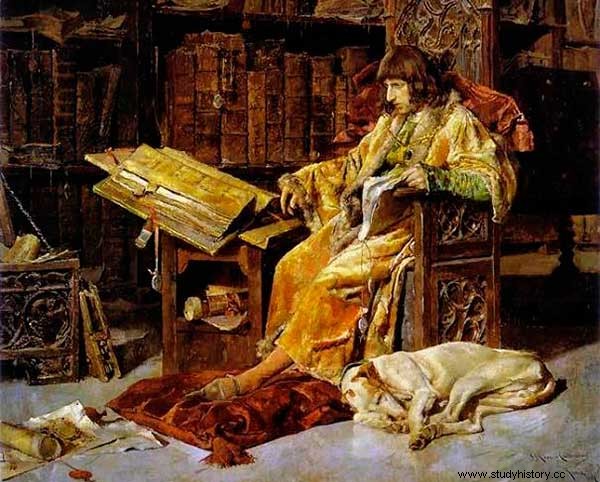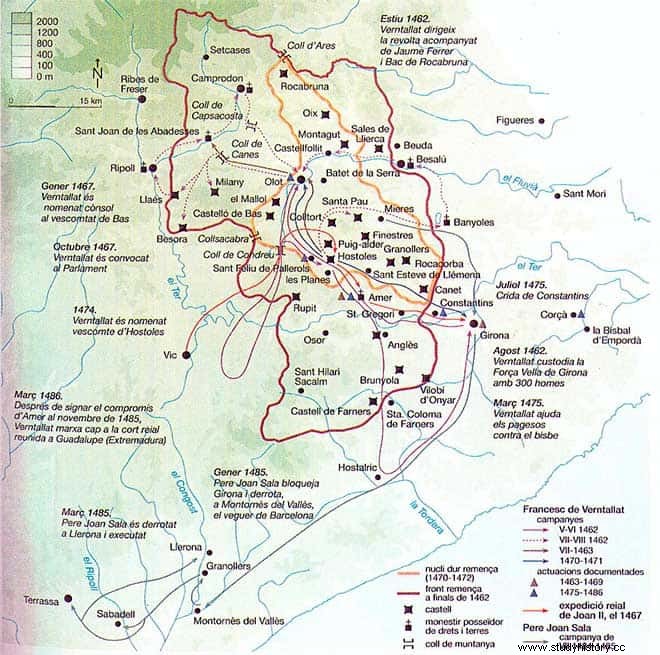The new Aragonese monarch was Juan II (1458-1479), brother of Alfonso V. Juan II had, when he acceded to the Aragonese throne, a long experience.
In Castile he had been the head of the group known as the 'infants of Aragon'. In Navarra, thanks to his first marriage to Blanca, he had been king consort since 1425 and effective monarch from 1441. But he had also held positions in the Crown of Aragon, where he was, among other things, Lieutenant General of Sardinia. and Sicily between the years 1415 and 1416.
Undoubtedly, the situation of the Crown of Aragon, and in particular of Catalonia, was extremely delicate.

Civil War background
Juan II had, for years, a conflict with his son Carlos, Prince of Viana and heir to the Kingdom of Navarre. That confrontation was projected in the Catalan sphere, where the sectors opposed to the monarch decided to lend support to the Prince of Viana. The Cortes of Lérida in 1460 confronted Juan II, who had to free Carlos, who was his prisoner at the time. Simultaneously, the Consell del Principat was constituted of Catalonia, made up of people from the nobility and the urban patriciate. Moreover, the following year the Consell came to proclaim Carlos de Viana heir to Catalonia. Faced with this panorama, Juan II agreed to negotiate, arriving, in June 1461, at the capitulation of Villafranca del Penedés. Said agreement, which, according to Josep María Salrach, collected all the political demands of the oligarchy since the time of Peter the Ceremonious , supposed an important brake for the aspirations of Juan II. Among other things, it was agreed that the Aragonese monarch could only enter Catalonia with the prior authorization of the Consell del Principat .
StartofCivilWar

The so-called pactist forces, that is, the dominant social sectors, that is, the great lords of the land, the urban patriciate and some leaders of the Church, had emerged victorious. In any case, the suspicious death of the Prince of Viana, just a few months after the aforementioned capitulation, marked a resounding change in the situation. Fernando, son of Juan II and his second wife, Juana Enríquez, was sworn heir to the Crown of Aragon . Meanwhile, Catalonia lived in an authentic pre-war climate. In February 1462, the peasants of remensa of lands of Gerona mutinied. A few days later, large groups of craftsmen demonstrated in Barcelona offering their unconditional support to Juan II. For its part, the Consell del Principat hastily recruited an army. On March 11, 1462, Juana Enríquez decided to leave Barcelona, accompanied by her son Fernando de ella .
That was the beginning of a hard civil war that lasted around ten years. On one side was King John II, who had, apart from French military aid, the support of the peasant farmers and the popular sectors of the cities. Opposite Juan II was basically the oligarchy, both rural and urban, represented by the Diputación del General, as well as some popular sectors that had embraced his cause. The rebels proposed placing the King of Castile, Enrique IV (1462), at the head of the principality and, after his resignation, they turned to the Constable Pedro de Portugal (1464-1466) and, finally, to Renato de Anjou (1466-1472). However, the development of the military confrontations gradually favored the royalist side.
Main Milestones of the Civil War
Let us remember some of the main milestones of that conflict:in 1462, Gerona, besieged by the rebels, managed to resist; in 1464 Lleida fell into royalist power; in 1465 the troops of Juan II defeated their rivals in Calaf, occupying, in the following months, among other towns, Cervera and Tortosa. Certainly, in the year 1467 the rebels won in Vilademat, which gave them control of Ampurdán. But the royalists reacted, achieving new successes in the last months of 1471, such as the recovery of Gerona and the victory of Santa Coloma de Gramanet. The fall of Barcelona, in October 1472, at the hands of Juan II, after a long siege, marked the end of the Catalan civil war . The surrender of the rebels resulted in the capitulation of Pedralbes. John II was conciliatory, which explains why there was neither repression nor purges. However, the relationship with the French monarchy became difficult, due to the fact that the Gallic king retained in his power the territories of Roussillon and Cerdanya, which John II had granted him in 1462, in compensation for his help, and that after the peace demanded of him. At the beginning of the year 1479 Juan II died, at the advanced age of eighty years.

